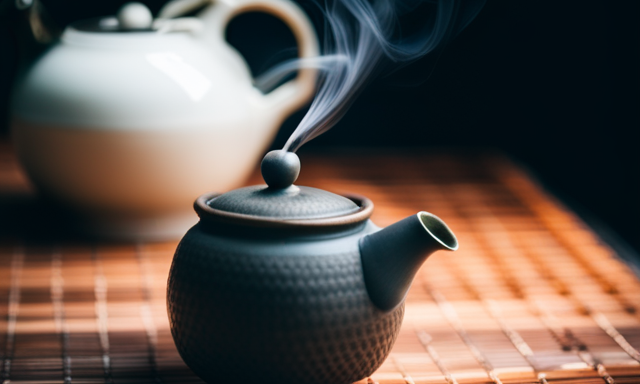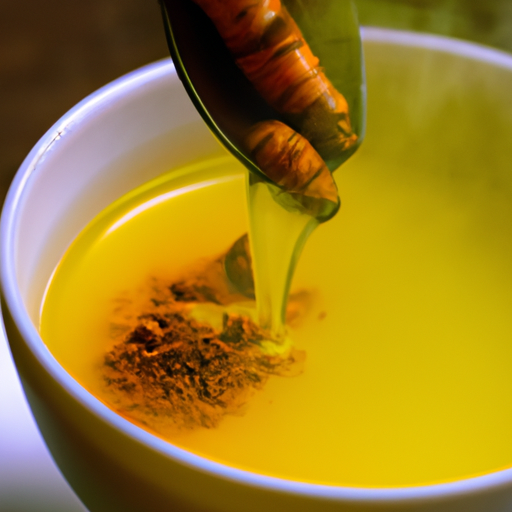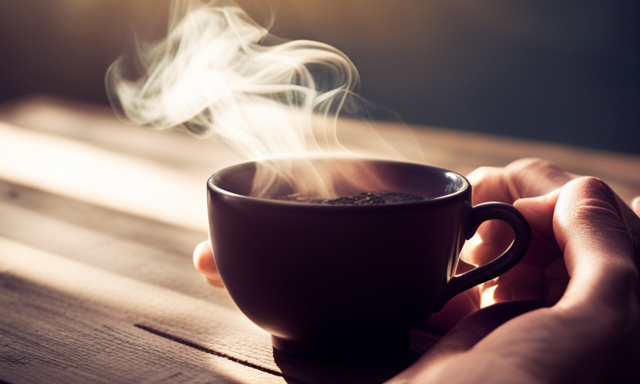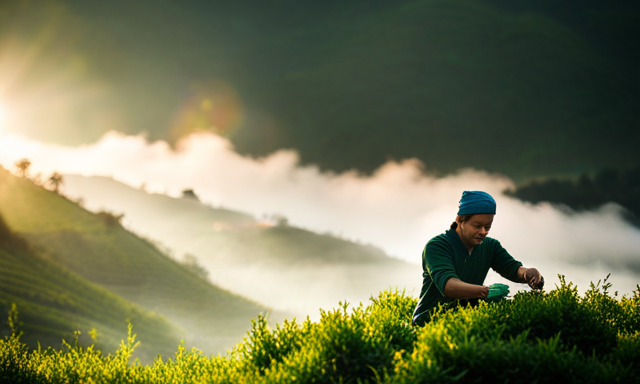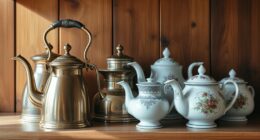Oolong tea is known for its perfect balance between black and green tea, offering unique flavor profiles and health benefits that have gained popularity among tea enthusiasts worldwide.
As a tea lover myself, I am excited to delve into the world of oolong tea and explore what goes into making this delightful beverage. In this article, we will uncover the origins of oolong tea, learn about the different varieties available, and understand the role of tea leaves in its production.
We will also explore the art of processing oolong tea and discover its distinct flavor profiles. Additionally, we will discuss the health benefits associated with drinking oolong tea and its significance in both traditional and modern culture.
So, grab a cup of oolong tea and join me on this fascinating journey into the world of what goes in it.
Key Takeaways
- Oolong tea is often used in tea ceremonies, symbolizing harmony, respect, and tranquility.
- Oolong tea can be incorporated into cuisine and cocktails, adding a unique twist to desserts and beverages.
- Oolong tea is popular in skincare products due to its antioxidant properties, promoting healthy skin.
- There are various brands and varieties of oolong tea available, each with its own distinct flavors and characteristics.
The Origins of Oolong Tea
The origins of oolong tea can be traced back to the Fujian province in China. It’s believed that this unique tea was first produced during the Ming Dynasty.
The process of making oolong tea involves withering the leaves under the sun, allowing them to partially oxidize, and then gently rolling and shaping them. This intricate process gives oolong tea its distinctive flavor and aroma.
Oolong tea is known for its complex taste profile, which can range from fruity and floral to woody and nutty. The different varieties of oolong tea offer a wide range of flavors and characteristics, making it a popular choice among tea enthusiasts.
Now, let’s explore the different varieties of oolong tea and discover their unique qualities.
Different Varieties of Oolong Tea
Discover the rich array of flavors found in various types of oolong tea, each offering a unique experience for you to savor. Oolong tea comes in different varieties, each with its own distinct flavor profile.
Some oolong teas have a floral aroma and a delicate taste, while others are more robust with hints of fruit or nut. The flavor of oolong tea can range from sweet and creamy to earthy and toasty.
Not only does oolong tea offer a delightful taste experience, but it also provides numerous health benefits. It’s known to boost metabolism, aid in digestion, and promote weight loss. Additionally, oolong tea contains antioxidants that can help protect against chronic diseases.
As we delve further into the world of oolong tea, let’s explore the role of tea leaves in creating these exquisite flavors.
The Role of Tea Leaves in Oolong Tea
Indulge your taste buds as we explore the magic that tea leaves bring to the captivating flavors of oolong.
-
Oxidation: One crucial aspect of oolong tea is the level of oxidation in the leaves. This process, where the tea leaves are exposed to oxygen, determines the flavor profile of the tea. From lightly oxidized teas with floral and fruity notes to heavily oxidized teas with rich and robust flavors, the level of oxidation plays a significant role.
-
Tea Leaf Quality: The quality of the tea leaves used in oolong tea directly impacts its flavor. High-quality leaves, plucked at the right time and carefully processed, result in a more complex and refined taste. These leaves contribute to the delicate balance of flavors that oolong tea is known for.
Understanding the role of oxidation and the impact of tea leaf quality on oolong tea flavor sets the foundation for appreciating the art of processing oolong tea, where craftsmanship and expertise transform these leaves into a remarkable beverage.
The Art of Processing Oolong Tea
Immerse yourself in the enchanting world of oolong tea as you witness the meticulous artistry that transforms humble leaves into a tantalizing elixir. The processing techniques of oolong tea play a vital role in bringing out its distinctive flavors and aromas.
From withering to rolling, oxidation to firing, each step is carefully executed to create the perfect balance of flavors. The importance of terroir, the environmental factors where the tea is grown, can’t be underestimated. The altitude, climate, soil composition, and even the surrounding flora all contribute to the unique characteristics of oolong tea.
These processing techniques and terroir combine to create a wide range of flavors, from floral and fruity to roasted and earthy. As we delve into the flavor profiles of oolong tea, get ready to be captivated by its complexity and depth.
Flavor Profiles of Oolong Tea
Get ready to embark on a sensory journey as you savor the myriad flavors that dance upon your tongue, revealing the intricate tapestry of notes found within the enchanting elixir of oolong tea. Oolong tea offers a wide range of flavor profiles, making it a versatile tea for pairing with various foods. From floral and fruity to toasty and nutty, each sip of oolong tea unveils a unique combination of flavors that harmonize perfectly with different cuisines. The fragrance of oolong tea is equally captivating, with its delicate and captivating aroma that entices the senses. To fully appreciate the complexity of oolong tea, consider pairing it with light seafood dishes or creamy desserts to enhance the tea’s natural sweetness. As we dive into the next section about brewing oolong tea, you will discover the art of extracting the perfect flavors from these tea leaves.
Brewing Oolong Tea
Prepare to embark on a tantalizing journey as you discover the art of brewing the perfect cup of oolong tea. Brewing techniques play a crucial role in extracting the full flavor and aroma from the leaves. Here’s how to brew oolong tea like a pro:
-
Water temperature: Boil water to around 195-205°F (90-96°C) to bring out the delicate flavors without scorching the leaves.
-
Tea to water ratio: Use 1 teaspoon of oolong tea per 8 ounces of water for a well-balanced brew.
-
Steeping time: Steep the tea for 2-4 minutes to allow the flavors to fully develop. Adjust the steeping time based on your personal preference.
-
Multiple infusions: Oolong tea can be steeped multiple times, each infusion revealing different nuances of flavor.
By mastering these brewing techniques, you can unlock the true potential of oolong tea. Now, let’s explore the health benefits of this exquisite beverage.
Health Benefits of Oolong Tea
After learning how to brew a perfect cup of oolong tea, let’s delve into its health benefits. Oolong tea is not only a delicious beverage but also a potent elixir for weight loss and heart health. This magical tea contains antioxidants and polyphenols that boost metabolism and aid in shedding those extra pounds. Additionally, research suggests that oolong tea may help lower cholesterol levels, reduce the risk of heart disease, and promote cardiovascular health. To provide you with a visual representation of the benefits, here is a table showcasing the remarkable effects of oolong tea on weight loss and heart health:
| Benefits of Oolong Tea | Emotion |
|---|---|
| Weight loss | Excitement |
| Lower cholesterol levels | Relief |
| Improved heart health | Gratitude |
Now that we understand the incredible health advantages of oolong tea, let’s explore its significance in both traditional and modern cultures.
Oolong Tea in Traditional and Modern Culture
Tea ceremonies and rituals are an integral part of traditional and modern culture, showcasing the art of preparing and enjoying tea. Oolong tea, with its unique flavor and aroma, has long been a popular choice for these ceremonial occasions.
In addition to its role in formal tea ceremonies, oolong tea is also used in cuisine and cocktails, adding a delightful twist to both sweet and savory dishes. Its versatility and distinct taste make it a favorite ingredient among chefs and mixologists alike.
Tea Ceremonies and Rituals
During a tea ceremony, you’ll carefully pour the hot water into the teapot, causing the delicate tea leaves to gently unfurl and release their aromatic essence. The art of tea ceremonies is deeply rooted in tradition and signifies harmony, respect, and tranquility.
Tea rituals have been practiced for centuries, evolving into intricate ceremonies that reflect cultural values and aesthetics. The beauty of these ceremonies lies in their attention to detail and the mindful preparation of each step. A tea ceremony often involves specific movements and gestures that convey grace and mindfulness. It creates a space for contemplation and connection, allowing participants to appreciate the subtle flavors and aromas of oolong tea.
As the tea ceremony concludes, the journey of oolong tea continues into the realm of cuisine and cocktails, where its unique characteristics can be explored and savored.
Oolong Tea in Cuisine and Cocktails
Indulge yourself in the rich and flavorful world of oolong tea-infused cuisine and cocktails, where every bite and sip transports you to a realm of culinary delights. Oolong tea is not only a popular beverage, but it also adds a unique twist to desserts.
From creamy oolong tea ice cream to delicate oolong tea-infused cakes, the possibilities are endless. The subtle floral and fruity notes of oolong tea elevate these sweet treats to a whole new level of sophistication and indulgence.
Additionally, oolong tea has made its way into the world of skincare. Its antioxidant properties make it a popular ingredient in facial masks and creams, known for promoting healthy and radiant skin.
So, whether you’re satisfying your sweet tooth or pampering your skin, oolong tea has got you covered. Now, let’s explore where to buy and enjoy this delightful tea.
Where to Buy and Enjoy Oolong Tea
When you’re on the hunt for oolong tea, you’ll find a plethora of delightful options waiting to be discovered, like hidden gems tucked away in a treasure chest. Here are some of the best oolong tea brands that I recommend:
-
Tie Guan Yin: Known for its floral aroma and smooth, mellow taste, this oolong tea is a classic choice.
-
Da Hong Pao: With its rich and roasted flavor, this oolong tea is perfect for those who prefer a bolder taste.
-
Ali Shan: This oolong tea is famous for its creamy texture and sweet, fruity notes.
-
Oriental Beauty: Also known as Bai Hao, this oolong tea has a distinct honey-like flavor that is truly unique.
-
Jin Xuan: With its milky and buttery taste, this oolong tea is a favorite among many tea enthusiasts.
When it comes to oolong tea recipes and pairings, I suggest trying it with seafood dishes like grilled shrimp or steamed fish. The delicate flavors of oolong tea complement the freshness of seafood perfectly. You can also enjoy oolong tea with light desserts like fruit tarts or almond cookies for a delightful afternoon treat.
Frequently Asked Questions
How long does it take to brew oolong tea?
Brewing oolong tea takes around 3-5 minutes, depending on your preference. To get the best flavor, use water heated to about 185-205°F and steep the leaves using a teapot or infuser.
Can oolong tea be consumed hot or cold?
Oolong tea can be enjoyed hot or cold. It offers numerous health benefits such as boosting metabolism and aiding in weight loss. With its delicate floral and fruity flavor profiles, oolong tea is a refreshing and delicious beverage.
Is oolong tea high in caffeine?
Oolong tea is moderately high in caffeine but still lower than black tea or coffee. It is generally safe during pregnancy, but moderation is key. It also has numerous health benefits, including aiding digestion and promoting weight loss.
Can oolong tea help with weight loss?
Oolong tea can help with weight loss due to its health benefits. It boosts metabolism, aiding in burning calories. Its antioxidants and catechins promote fat oxidation, making it a great addition to a weight loss regimen.
What are some popular oolong tea blends?
Popular oolong tea blends range from floral and fragrant to fruity and invigorating. Each blend offers unique flavors and aromas that cater to different preferences. These blends not only taste delicious but also provide numerous health benefits associated with oolong tea.
Conclusion
In conclusion, after exploring the origins, varieties, processing, and flavor profiles of Oolong tea, it’s safe to say that this remarkable beverage is a true masterpiece of nature. Its delicate and complex flavors, ranging from fruity to floral, make every sip a journey of the senses.
The health benefits of Oolong tea are numerous, from boosting metabolism to promoting heart health. So, if you want to experience the epitome of tea perfection, indulge in some Oolong tea, and let its enchanting flavors transport you to a world of pure tea bliss.

